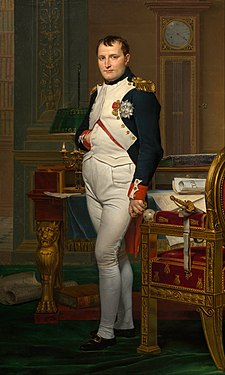Napoleon
From Wikipedia, the free encyclopedia
This article is about Napoleon I. For other uses, see Napoleon (disambiguation).
| Napoleon | |||||
|---|---|---|---|---|---|

| |||||
| Emperor of the French | |||||
| Reign | 18 May 1804 – 11 April 1814 20 March 1815 – 22 June 1815 | ||||
| Coronation | 2 December 1804 | ||||
| Predecessor | Himself as First Consul | ||||
| Successor | Louis XVIII (de jure in 1814) | ||||
| King of Italy | |||||
| Reign | 17 March 1805 – 11 April 1814 | ||||
| Coronation | 26 May 1805 | ||||
| Predecessor | Himself as President of theItalian Republic | ||||
| Successor | None (kingdom disbanded, next king of Italy was Victor Emmanuel II) | ||||
| Spouse | Joséphine de Beauharnais Marie Louise of Austria | ||||
| Issue | Napoleon II | ||||
| |||||
| House | House of Bonaparte | ||||
| Father | Carlo Buonaparte | ||||
| Mother | Letizia Ramolino | ||||
| Born | 15 August 1769 Ajaccio, Corsica, France | ||||
| Died | 5 May 1821 (aged 51) Longwood, Saint Helena | ||||
| Burial | Les Invalides, Paris, France | ||||
| Religion | Roman Catholicism(excommunicated on June 10, 1809[1] - see Religions section) | ||||
| Signature | |||||
Napoléon Bonaparte (/nəˈpoʊliən, -ˈpoʊljən/;[2] French: [napɔleɔ̃ bɔnapaʁt], born Napoleone di Buonaparte; 15 August 1769 – 5 May 1821) was a French military and political leader who rose to prominence during the latter stages of the French Revolution and its associated wars. As Napoleon I, he was Emperor of the French from 1804 to 1814 and again in 1815. Napoleon dominated European affairs for almost two decades while leading France against a series of coalitions in the Revolutionary Wars and the Napoleonic Wars. He won the large majority of his battles and seized control of most of continental Europe before his ultimate defeat in 1815. One of the greatest commanders in history, his campaigns are studied at military schools worldwide and he remains simultaneously one of the most celebrated and controversial political figures in European history.[3] In civil affairs, Napoleon implemented a wide array of liberal reforms across Europe, including the abolition of feudalism, the establishment of legal equality and religious toleration, and the legalization of divorce. His lasting legal achievement, the Napoleonic Code, has been adopted to varying degrees by dozens of nations around the world.[4][5]
Napoleon was born in Corsica to a relatively modest family of noble Italian ancestry that had settled on the island in the 16th century. Well-educated and an avid reader, he spoke French with a heavy Corsican accent. A supporter of the radical Jacobin faction, his military skills led to very rapid promotions under the Republic. He became the leading figure of the Revolution after his celebrated military campaigns in Italy and Egypt from 1796 until 1799.
Napoleon took power in 1799 and installed himself as First Consul with few restrictions on his control of France. In 1804 he was crowned emperor of the French people. He made peace with the pope and the Catholic Church, much to the relief of the religious element. He launched a new aristocracy for France while allowing the return of most of the aristocrats who had been forced into exile by the Revolution. He fought a series of wars—the Napoleonic Wars—that involved complex ever-changing coalitions against the French Empire. With his victories at Ulm and Austerlitz in 1805, he put an end to the Third Coalition, then he dissolved the old Holy Roman Empireand created the Confederation of the Rhine. However, his navy was destroyed at the Battle of Trafalgar in October 1805 and Britain imposed a naval blockade of the French coasts. In retaliation, he established the Continental System to cut off all European trade with Britain. A Fourth Coalition was set up against France, but it was defeated at the battles of Jena-Auerstedt in 1806 and again at the Battle of Friedland in 1807. These French victories resulted in the dismemberment of Prussia and the resurgence of a Polish State. At Wagram in 1809, Napoleon dissolved a Fifth Coalition and secured a dominant position in continental Europe.
Napoleon maintained the French sphere of influence through the formation of fluctuating alliances and the elevation of friends and family members to rule other European countries as French vassal states. Napoleon was himself President (1802–1805), then king of Italy (1805–1814), Mediator of the Swiss Confederation (1803–1813) and Protector of the Confederation of the Rhine (1806–1813). In late 1807, Napoleon tried to compel Portugal to follow the Continental System. The following year he declared his brother Joseph Bonaparte the King of Spain, which precipitated the outbreak of the Peninsular War, widely noted for its brutal guerrila conflict. The war also featured the participation of the British army and substantially drained French resources over time.
To enforce the Continental blockade, he launched a large-scale invasion of Russia in 1812 that proved to be a major military failure. Much of the Grande Armée was destroyed in the campaign due to disease. Most European countries then turned against him. The Sixth Coalition defeated him at the Battle of Leipzig in October 1813 and then invaded France. Napoleon was forced to abdicate by April 1814, ending up exiled to the island of Elba. Most French territorial gains since 1792 were reversed and the Bourbons were restored to power. In 1815, he escaped from Elba and returned to power for roughly one hundred days, but was finally defeated at the Battle of Waterloo. He spent the last six years of his life in confinement by the British on the remote island of Saint Helena. He was the great hero of the French people throughout the 19th century, and his nephew Napoleon III built on that fame to become ruler of France from 1848 until 1870.


No comments:
Post a Comment